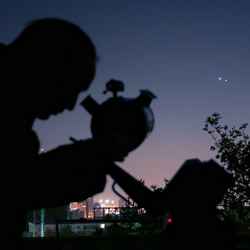
Similar close encounter last November. Image credit: Babak A. Tafreshi Click to enlarge
Something nice is happening in the sunset sky. Venus and Jupiter, the two brightest planets, are converging, and they’re going to be beautifully close together for the next two weeks.
Step outside tonight when the sun goes down and look west. If there are no trees or buildings in the way, you can’t miss Jupiter and Venus. They look like airplanes, hovering near the horizon with their lights on full blast. (Venus is the brighter of the two.) You can see them even from brightly-lit cities.
Try catching the pair just after sundown and just before the first stars appear. Venus and Jupiter pop into view while the sky is still twilight-blue. The scene has a special beauty.
When the sky darkens completely, look to the left of Jupiter for Spica, the brightest star in the constellation Virgo. Although it’s a bright star, Spica is completely outclassed by the two planets.
Venus and Jupiter are converging at the noticeable rate of 1o per day, with closest approach coming on September 1st when the two will be a little more than 1o apart. (How much is 1o? Hold your pinky finger at arm’s length. The tip is about 1o wide.)
When planets are so close together, not only do you notice them, you’ll have a hard time taking your eyes off them. They’re spellbinding.
There’s a biological reason for this phenomenon: In the back of your eye, near the center of the retina, lies a small patch of tissue called “the fovea” where cones are extra-densely packed. “Whatever you see with the fovea, you see in high-definition,” explains Stuart Hiroyasu, O.D., of Bishop, California. “The fovea is critical to reading, driving, watching television; it has the brain’s attention.” The field of view of the fovea is 5o. When two objects converge to, say, 1o as Venus and Jupiter will do, they can beam into your fovea simultaneously, signaling your brain?attention, please!
After September 1st, the two planets separate, but the show’s not over. On September 6th, with Jupiter and Venus still pleasingly close together, the slender crescent Moon will leap up from the sun’s glare and join the two planets. Together, they’ll form a compact triangle that will simply knock your socks off.
Feel like staring? Do.
Original Source: NASA News Release

After reading the article, I feel that I really need more information on the topic. Can you suggest some resources ?